The Economics and Statistics Division maintains archives of previous publications for accountability purposes, but makes no updates to keep these documents current with the latest data revisions from Statistics Canada. As a result, information in older documents may not be accurate. Please exercise caution when referring to older documents. For the latest information and historical data, please contact the individual listed to the right.
<--- Return to Archive
For additional information relating to this article, please contact:
August 16, 2021MULTIFACTOR PRODUCTIVITY GROWTH, 2019 Statistics Canada has released provincial results for multifactor productivity and related variables for the business sector for 2019.
Growth in Real GDP can be decomposed into growth in hours worked and growth in labour productivity. Growth in labour productivity can be further decomposed into growth in capital intensity (ie: the amount of capital used in production), labour composition (ie: skills upgrading) and multifactor productivity. Multifactor productivity is the residual of economic growth that cannot otherwise be accounted for and is meant to reflect intangible contributions to economic growth from unobserved variables such as branding, economies of scale, technology or management practice.
Previously-released data showed that Canadian labour productivity increased 0.8% in 2019 and along with rising hours worked (+0.7%) lifted real GDP 1.6%. Productivity growth was largest in Atlantic region and Quebec. There were smaller labour productivity increases in Alberta and British Columbia and a notable decline in labour productivity in Saskatchewan. Ontario and Manitoba had smaller changes in labour productivity in 2019.
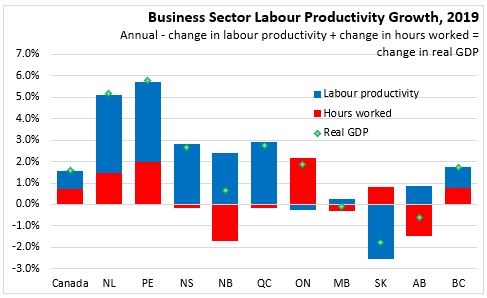
New results released today further decompose the sources of provincial labour productivity growth and decline in 2019. Rising multifactor productivity in the Atlantic region and Quebec made the largest contribution to labour productivity growth in 2019. Multifactor productivity declined in the other five provinces. Capital intensity made positive contribution in all provinces except Saskatchewan (-0.6%) and Newfoundland and Labrador (0.0%). Labour composition had the largest effect for British Columbia (+0.5%) and Manitoba (+0.4%) labour productivity in 2019.
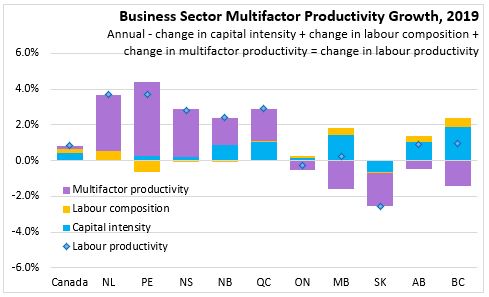
From 2013 to 2017, Nova Scotia's labour productivity rose in each year, posting the strongest growth since the late 1990s. This productivity gain was partially reversed in 2018, though a large rise in the number of hours worked kept Nova Scotia's real GDP growth positive for the year. In 2019, labour productivity increased 2.8% in Nova Scotia. Hours worked declined 0.1%, resulting in business sector real GDP increasing 2.6% in 2019.
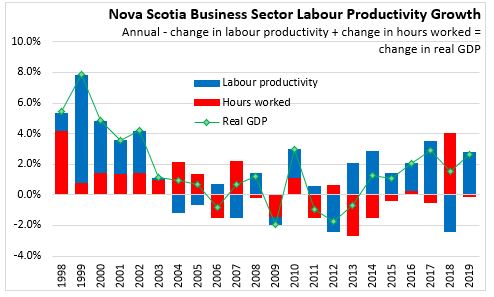
From 2013-2017, Nova Scotia's labour productivity growth was attributable to rising capital intensity and multifactor productivity. Both capital intensity and multifactor productivity of Nova Scotia businesses declined in 2018. In 2019, multifactor productivity (+2.7%) and capital intensity (+0.2%) resumed growth. Labour composition in 2019 declined 0.1% in Nova Scotia.
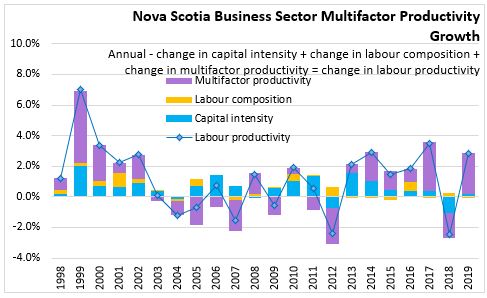
Among industries, Nova Scotia's 2019 labour productivity growth was strongest in wholesale trade; agriculture, forestry, and fishing; retail trade; transportation and warehousing; and accommodation and food services. There was a notable decline in mining and oil and gas extraction in 2019. Within the business sector, labour productivity was up 0.3% in the goods-producing sectors and 3.8% in the services-producing sectors in 2019.

The decline in mining and oil and gas extraction labour productivity resulted from lower multifactor productivity and capital intensity in the sector. Most other sectors, except utilities, transportation and professional, scientific and technical services had positive multifactor productivity growth in 2019. Capital intensity made large positive contribution to labour productivity in the transportation sector. In the goods-producing sector, multifactor productivity (+2.3%) and labour composition (+0.4%) offset a decline in capital intensity (-2.2%) to leave labour productivity (+0.3%) in positive territory. Within business service-producing sector, labour productivity growth (+3.8%) can be decomposed into positive contributions from multifactor productivity (+2.6%) and capital intensity (+1.3%) and the small decline in labour composition (-0.1%).
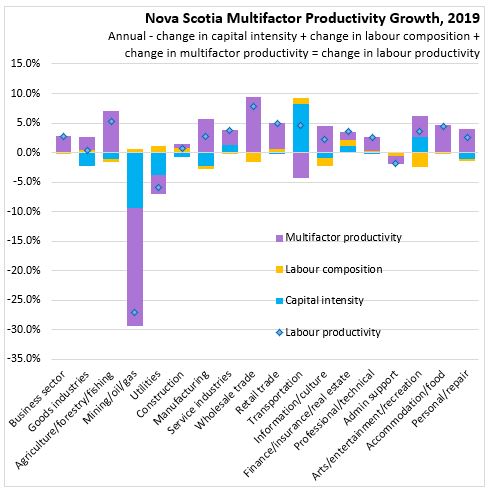
From 2012 through 2019, hours worked have increased faster in professional/technical, administrative support (including call centres), arts/entertainment/recreation, accommodation/food, personal/repair services, transportation and utilities. Growth in all other industries relied on productivity gains to boost output.
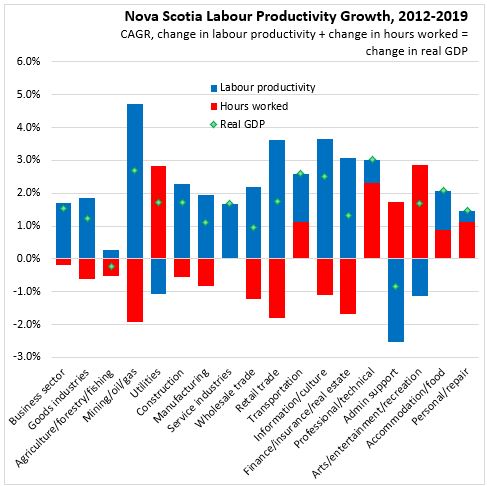
Since 2012, multifactor productivity has been positive in all sectors except utilities; transportation; Administrative and support, waste management and remediation services; and arts, entertainment and recreation. Capital intensity growth has been most notable in transportation, information and cultural, and finance, insurance and real estate. For goods-producing sector only multifactor productivity growth has been positive over 2012 to 2019. Within the service-producing sectors all three subcomponents have contributed to labour productivity growth.
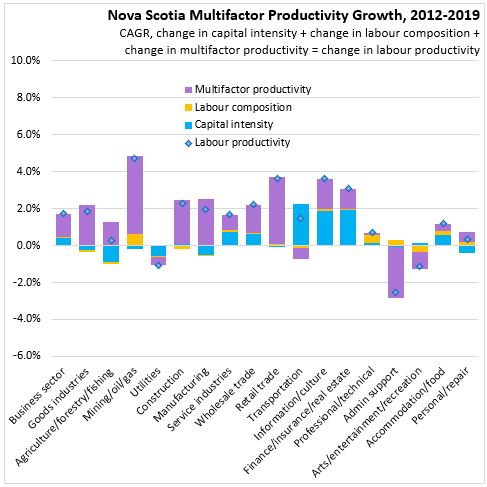
Statistics Canada. Table 36-10-0208-01 Multifactor productivity, value-added, capital input and labour input in the aggregate business sector and major sub-sectors, by industry; Table 36-10-0211-01 Multifactor productivity and related variables in the aggregate business sector and major sub-sectors, by industry
<--- Return to Archive